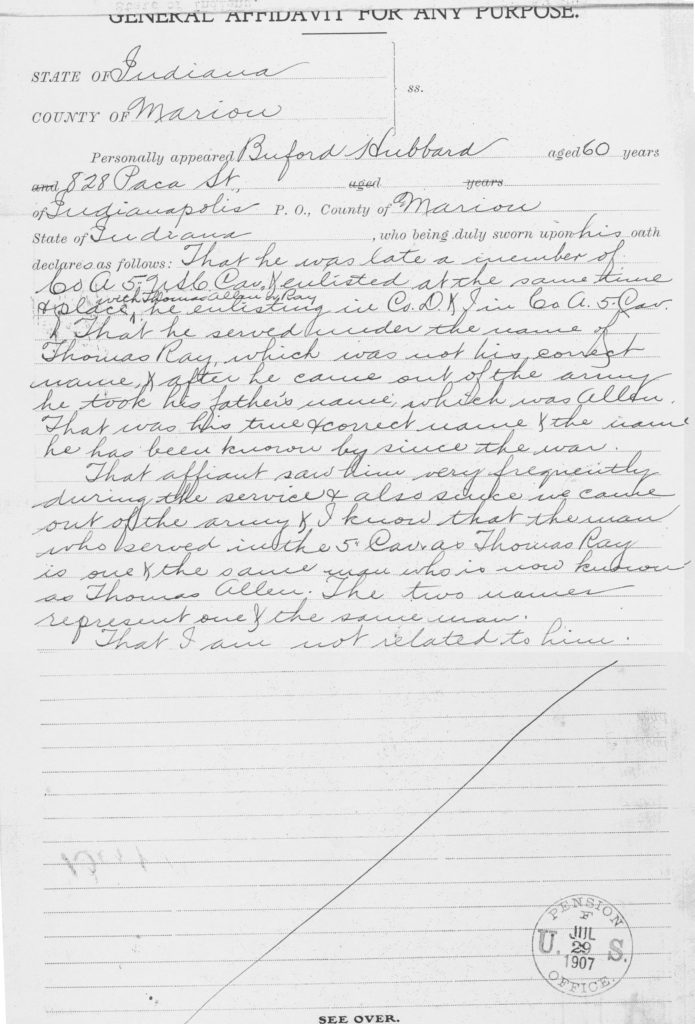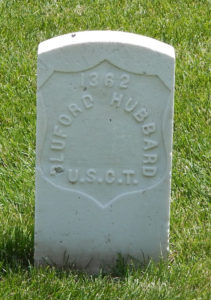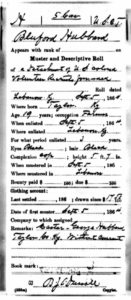On September 5, 1864, Bluford Hubbard enlisted in the United States Colored Troops (Calvery) in Lebanon, Kentucky. He was 19 years old. It was a month after Thomas Ray Allen had enlisted. Bluford was born about 1845 in Taylor County, Kentucky.
On his enrollment papers he is described as 5 ft 7 in, copper colored with black hair and black eyes. He had been enslaved by George Hubbard of Taylor County and enlisted without his consent. Bluford served along with Thomas until the end of the Civil War in 1866 and was mustered out in Helena, Arkansas.
Bluford returned to Taylor county and a year later married Eunice Buckner. They lived near to his mother Rachel Gaddie and several of his siblings. Bluford farmed and Eunice kept the house and worked along with him. Six children were born to them but only two lived to adulthood, John born in 1872 and Lewis born in 1878.
By the late 1880s the family had moved to Indianapolis, Indiana. In 1887 Bluford began to receive an invalid pension. He testified for the first time in 1897 that he knew Thomas Allen to be one and the same as Thomas Ray because he had served with him in the army and also continued to see him over the years.
He is listed as a pensioner in the 1900 census. He and his wife Eunice have been married 33 years. Six people lived in the household on Paca. The two sons are listed as common laborers. Eunice’s younger sister, Fannie, is living with them and both Eunice and Fannie are taking in washing. Seven year old nephew Burford Palmer is also a part of the household. The three younger members of the household are literate. The older ones are not.

In 1908 Bluford was admitted to the Old Soldiers Home in Center, Grant, Indiana. He was still enumerated with his family in the 1910 census. Eunice is doing laundry for a private family, both sons are laborers. Nephew Burford is 16 and an actor and comedian. There is one border who is also a laborer. The family is still renting the house at 868 Paca Street.
Bluford Hubbard died on February 2, 1915 of chronic nephritis (inflamation of the kidneys). His son Lewis was the informant on the death certificate and gave Bluford’s parent’s names as Zealer Hubbard and Rachel Gaddie. He was buried in Crown Hill Cemetery and has a veteran’s headstone.
His son John died in 1929 of a pulmonary hemorrhage brought on by tuberculosis. Bluford’s widow, Rachel, lived for another 20 years after her husband’s death, dying in 1935 at the age of 84 of bronchial pneumonia. Lewis disappeared after the 1920 census.
*Resources I used to find the information in this post: 1870, 1880, 1900, 1910, 1920 and 1930 US censuses; Indianapolis City Directories; Bluford’s military records; death certificates for Bluford, Eunice and John Hubbard; records found in Thomas Ray Allen’s pension file. The photograph of Bluford’s gravestone is from find-a-grave. Except for the pension file, which I have in my possession, I found these records on Ancestry.com and familysearch.com I also did a bit of random googling if something called for it.


Oh! I have always thought that the Coloured Troops were voluntary. I mean, that men enroled because they wanted, not because they were forced.
Obviously, I was mistaken…
@JazzFeathers
The Old Shelter – 1940s Film Noir
No, they were voluntary! What did I say that made you think they weren’t?
Hey, it’s working today!
I had an argument recently with relatives about how teaching kids cursive is not a useful or practical skill. That being said, if you didn’t know cursive you would be unable to read most of these old documents, so I guess it’s important that SOMEONE learn it.
(I still don’t think it’s useful in day-to-day life, but I admit it has its place)
I think they should have kept on teaching it like they did back when. I don’t think it did any damage and it would allow you to read your grandparents love letters, or USCT files. Who knows who will want to do that later? Probably good for hand eye coordination and small motor skills too. I write a lot of cursive in my day to day life. Most people probably don’t write at all though. I write my grandkids postcards in cursive from time to time. I just forget to print. Hope they can read them.
The Burford testimony is quite a find and a pleasure to read after all this time. May cursive writing never die!
My feelings too! The testimony was part of Thomas’ pension file. I should mention that in the post.
I’m also a fan of cursive, which some schools have begun reintroducing. How else could you read that wonderful pension document linking Bluford with Thomas Allen? This is a fascinating family saga so far.
Exactly!
Fantastic piece of research – and what a story behind it all.
Phillip | B is for banana
I probably don’t even know the half of it. Imagine if someone was recreating your life using only records.
Yes I agree, the records are helpful but the real character is elusive. The records give undue prominence to things that possibly were not that important in the scheme of things and certainly overlook Day to day experiences.
I really like how you said you found the information which would be a great help to somebody new to research.
Yes, you need some family stories or a diary or journal, even some newspaper articles would help flesh them out.
Wow, that is a lot of research. So much detail. I wonder what happened to Lewis.
Tasha
Tasha’s Thinkings – Shapeshifters and Werewolves
I wonder too. Maybe he died or moved away. Or hid from the census enumerators. Or shifted shape…
I love looking at those old documents. There’s so much history stored up in those words. It makes me wonder how this sort of research will change with the internet; in the future will our descendants be looking up old Facebook and Twitter posts?
Cait @ Click’s Clan
I hope we leave more than that because Facebook and Twitter and even our blogging platforms will probably not be here in 100 years.
Went to private school where you learned to print first. Then at about the 3rd or 4th grade you learned cursive writing. First w/ pencil but then w/ a fountain pen – believe a Schaeffer – w/ an ink cartridge. We all thought we were hot stuff when we graduated to a fountain pen. Of course, ball point pens were also involved. It’s kind of shocking to learn that cursive writing isn’t taught any more.
There is a handwriting analyzer named Sheila Lowe. She wrote “The Complete Idiot’s Guide to Handwriting Analysis.” [2000]. It’s very interesting. She talks about loops, the personal pronoun I, connections and other interesting stuff pertaining to handwriting. Let’s hope handwriting returns.
Best to you.
Pascal Behr
I learned to write cursive in the 3rd grade too. I don’t remember getting to use a pen before high school though. I do hope handwriting returns and I will look for the guide once A to Z is over.
Great research! Thanks for sharing this.
Thanks for reading!
There is a rich source of information within these pension records. I love how neighbors and relatives gave depositions about the life of the pensioner. My Markham men eligible to serve with the USCT didn’t serve but I discovered depositions by them in the pension records of neighbors. I am enjoying this series.